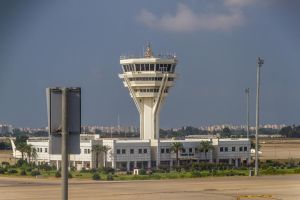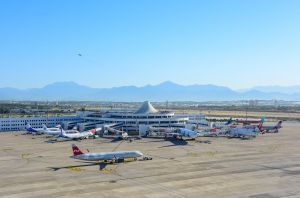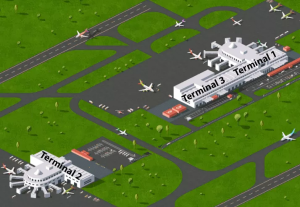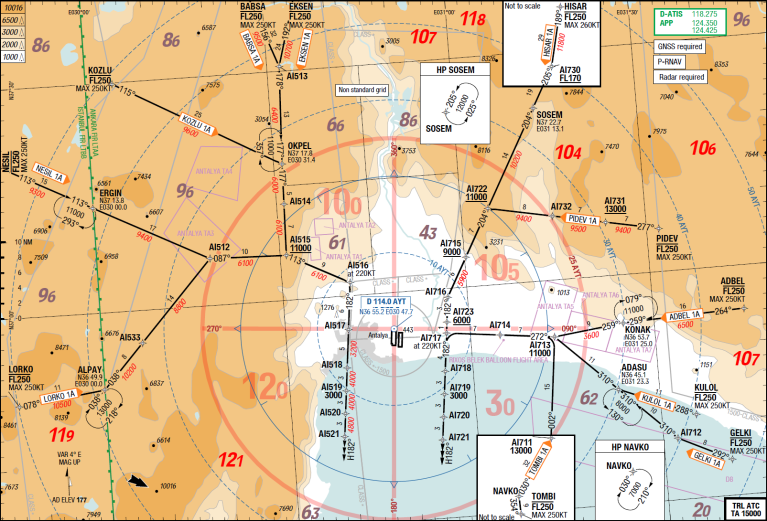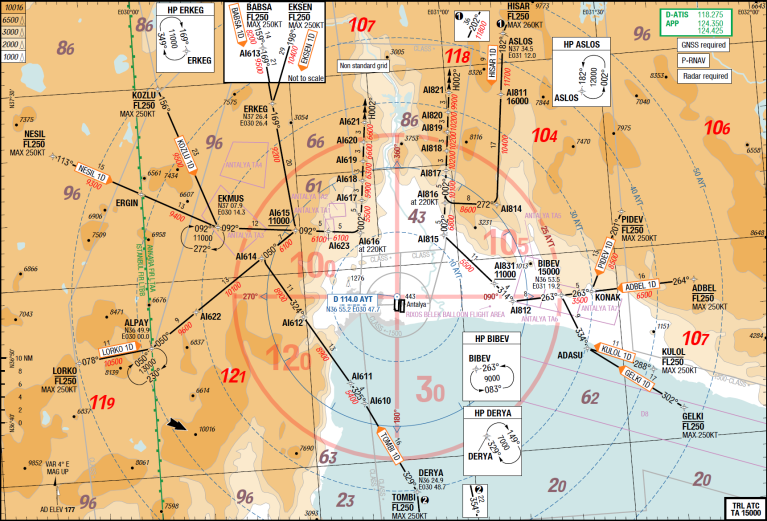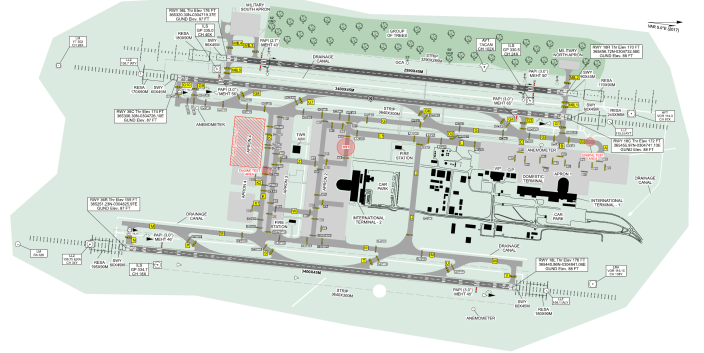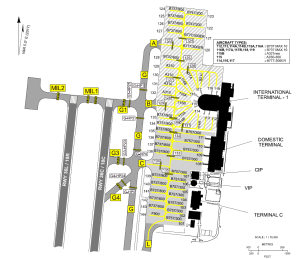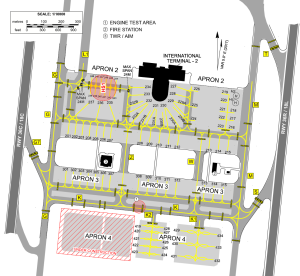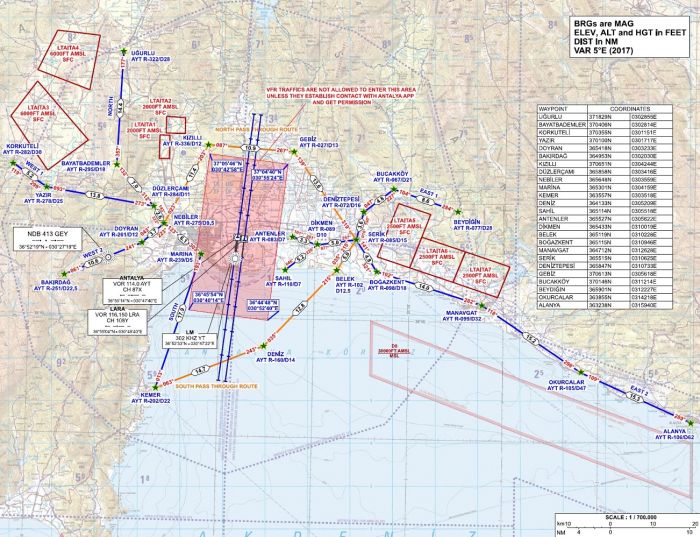Antalya Airport
The Antalya Airport (IATA: AYT, ICAO: LTAI) is the 2nd busiest airport in Türkiye, a major international leisure destination in the southwest. It is one of the three airports located within the Turkish Riviera, others being Milas-Bodrum Airport and Antalya Airport. There are 3 runways (36L/18R, 36C/18C, 36R/18L), 3 aprons, one domestic terminal and two international terminals. Apron 2 has small area for GA aircraft such as C172s, DA20, DA42 etc. The 36L/18R runway is used for military and emergency only whereas 36C/18C and 36R/18L is open to all types of traffic. The city and the airport are surrounded by Taurus Mountains, stretching from west to north, then to east of the airport, encapsulating the Antalya plain.
Scenery
Payware
Antalya Airport (LTAI) has payware sceneries for each simulator. You can find them in the table below.
| Simulator | Developer | Publisher | Links |
|---|---|---|---|
| P3D v4/v5 | JustSim | SimMarket | https://secure.simmarket.com/justsim-antalya-international-airport-ltai-v.2-p3d-v.5.phtml |
| X-Plane 11/12 | JustSim | SimMarket | https://secure.simmarket.com/justsim-antalya-airport-ltai-v.2_x-plane-11.phtml |
| Microsoft Flight Simulator | JustSim | SimMarket or
Marketplace |
Can be bought from MarketPlace
OR https://secure.simmarket.com/justsim-antalya-international-airport-ltai-msfs.phtml |
Freeware
| Simulator | Developer | Publisher | Links |
|---|---|---|---|
| FSX (somewhat works with P3D) | Murat Koncavar (biber) | SanalPilot | http://www.sanalpilot.com/forum/showthread.php?17243-LTAI2014-FSX-i%E7in-LTAI-Antalya-Uluslararas%FD-Havalimani |
| FSX | JMS Designs | AVSIM Library | https://library.avsim.net/download.php?DLID=218835 |
| X-Plane 11/12 | Leroy29 | X-Plane Org | https://forums.x-plane.org/index.php?/files/file/79358-ltai-antalya/ |
| Microsoft Flight Simulator | Argaeus | FlightSim.to | https://flightsim.to/file/5251/ltai-antalya-intl-airport |
Preferential Runway System (PRS)
The term “Preferential RWY System (PRS)” shall be used to indicate the runway that, at a particular time, is considered by the ATC unit to be the most suitable for use by the aircraft expected to land at or take-off from the aerodrome, by taking into consideration aircraft performance, surface wind speed and its components. PRS Operations contribute to the optimum use of airspace and aerodrome capacity.
Preferential RWY for Antalya Airport (LTAI) are the north configuration runways (RWY 36C & 36R)
| RWYCC (Runway Condition Code) | Tail Wind Component (max) |
|---|---|
| RWYCC 6/6/6
(dry, maximum braking) |
10 KT (included) |
| When RWYCC is reported at least 5 for any each runway third
(worse than dry, low braking |
5 KT (included) |
- In the PRS operations, the above wind criteria depending on the runway surface condition shall be applied.
- During the PRS operations, ATC unit takes into account the ground wind, traffic situation, local meteorological conditions, environmental restrictions, technical infrastructure, noise abatement, etc.
- PRS operations will not be available under the following circumstances:
- The instrument approach/departure procedures available for the preferred RWY(s) are not convenient for landing and/ or take-off operations under the existing meteorological conditions
- When the preferred RWY(s) are dry (RWYCC[1] 6/6/6), the tail wind component is greater than 10 Kt,
- When RWYCC is reported at least 5 for any each the preferred RWY(s) third, the tail wind component is greater than 5 Kt,
- When RWYCC is reported at least 5 for any each the preferred RWY(s) third, there is a NOTAM/equivalent information (which may be included in the RCR) stating that the runway is slippery,ATIS announcement when PRS Operations are in progress shall be; “Preferential Runway Operations are in Progress”.
- RWYCC is reported 4 or less any each the preferred RWY(s) third,
- Meteorological conditions such as heavy rainfall, thunderstorm or wind-shear has been reported on the approach or climb path of the preferred RWY(s),
- Low visibility operations are in progress.
- ATIS announcement when PRS Operations are in progress shall be; “Preferential Runway Operations are in Progress”.
- Pilots unable to comply with PRS Operations shall notify the relevant ATC unit at the time of requesting start-up clearance, at the first contact or 20 minutes in advance of the ETA (which is earlier).
Arrival Procedures
Antalya airport is located within Antalya TMA and utilizes RNAV for its arrival procedures. In addition, P-RNAV (Precision-Area Navigation, RNP1) capability is required. If unable, pilot must inform the controller so that aircraft can be given radar vectors to final. When contacting Antalya APP for the first time, report callsign and inbound waypoint only.
Important things to keep in mind:
- Always try to vacate via high speed exits
- Do not stop on the high speed exists, enter parallel taxiway if necessary
- Transponder should be set to MODE-C until engine shutdown at gate or stand as aircraft has A-SMGCS (Advanced-Surface Movement Guidance Control System)
- AN124, AN225, A380 and B748 are not permitted to operate to/from Antalya Airport.
- East of the airport have bird activity and pilots are advised to be careful. Especially at low altitudes and close to bird routes.
STARs
| Active Runway Configuration | ||||
|---|---|---|---|---|
| North Config (RWY 36C/R) | ||||
North Configuration uses the following STAR identifiers.
| ||||
| South Config (RWY 18L/C) | ||||
South Configuration uses the following STAR identifiers.
|
North Configuration (RWY 36C/R)
The default arrival procedure for north configuration (active runway 36C and/or 36R) are RNAV STARs that have -1A designator. These procedures require GNSS and P-RNAV (RNP1) capabilities. If the necessary navigational performance is lost or not available, pilots should inform the ATC immediately. The STAR structure is designed to carefully navigate the aircraft through Taurus mountains then over the city and sea to south, following a specific descent profile. All aircraft are required to follow STAR restrictions (both speed and altitude). Upon reaching downwind, aircraft are vectored to the final. According to the intensity of the traffic, you might receive speed restrictions and shortcuts in downwind. After reaching final waypoint of the downwind (AI521 or AI721), all aircraft should maintain their present heading and should not turn to IAF, FAF or final until instructed by the APP controller.
Expect ILS-Y for runway 36C and ILS-V for runway 36R. The approach procedure could be different at the time of the flight. Always check Arrival ATIS and ask approach controller.
South Configuration (RWY 18L/C)
Just like north configuration arrivals, south configuration arrivals utilize RNAV technology and have -1D designator. GNSS and P-RNAV (Precision RNAV or RNP1) capability is required. If not available, pilots should inform approach controller immediately. Due to Taurus Mountains and the geography of the area, when compared to the -1A STARs, downwind is further away from the airport to have the arrival traffics to descend over the valley and final.
Expect ILS-Z for runway 18C and ILS-Z for runway 18L. The approach procedure could be different at the time of the flight. Always check Arrival ATIS and ask approach controller.
Ground Operations
Ground Layout
There are 3 aprons and 3 terminals in Antalya (for civil flights). International Terminal 1 and Domestic Terminal (terminal 3) is situated in Apron 1 whereas International Terminal 2 and GA area is in Apron 2. MARS (Multiple Aircraft Ramp System) is used in international terminals. This system allows 1 gate to be used by 2 narrowbody aircraft at the same time or 1 widebody aircraft
Apron, Gates and Stands
Apron 1
International Terminal 1, Domestic Terminal, CIP, VIP and few other facility buildings are located in Apron 1. Each gate and stand have different wingspan restriction and can be found on the left image (max aircraft type is shown per stand). Terminal 1 serves as international terminal and Terminal 3 (domestic terminal) serves as Domestic Terminal (flights within Turkey). In total, there are 24 medium stands, 16 medium gates, 8 heavy stands and 4 heavy gates. Gates 114, 115, 116 and 117 have MARS (Multi-Aircraft Ramp System).
Military Apron
There are 2 military aprons west of RWY 36L/18R, which is used only by Turkish Military, mainly TUAF (Turkish Air Force), Search and Rescue, Aerial Firefighting and few other special operations..
Apron 2, 3 and 4
Located between 36C/18C and 36R/18L, Apron 2 houses International Terminal 2, ARFF and ATS facilities. The apron is used by multiple types of aircraft, from small, medium, heavy to helicopters. There are 38 medium stands, 12 medium gates, 6 heavy stands and 4 heavy gates. Gates 229, 230, 231 and 232 utilize MARS system. Stands 238-249 are dedicated GA aircraft.
Apron 3 consists of 15 medium only stands, these stands can take aircraft that are as big as 757s.
Apron 4 is one of the newest additions to the airport. As with current expansion project going, there will be few more aprons being added in the following years. At the moment, there is only 2 parts of Apron 4 completed, with the west part being worked on. As of July 2023, this apron has 10 medium, 6 heavy stands.
Planning Taxi Time
In Antalya Airport, taxi times are different for each config (north or south). When north config is active, the taxi time for departure can be 10-15 minutes from Apron 1 and 5-10 minutes from Apron 2. When south config is active, taxi times are 5-10 minutes from Apron 1 and 10-15 minutes from Apron 2 (depending on the traffic intensity).
ATIS
There are 2 ATIS frequencies in Antalya. One is for arrivals (LTAI_A_ATIS) and one is for departures (LTAI_D_ATIS). Arrival traffic should check LTAI_A_ATIS and departure should check LTAI_D_ATIS. From ATIS you can receive information about:
- Active runways for departure
- Active runways/procedures for arrival
- Airborne frequency
- Weather and conditions
- Transition Level
Departure ATIS example:
ANTALYA AIRPORT, ATIS INFORMATION, CHARLIE, ONE SIX TWO ZERO ZULU, DEP RWY, 36R. DEPARTURE FREQUENCY 119.650. CAUTION BIRD ACTIVITY, RUNWAY DRY. WIND THREE TWO ZERO DEGREES ONE TWO KNOTS. END OF ATIS INFORMATION, CHARLIE.
Arrival ATIS example:
ANTALYA AIRPORT, ATIS INFORMATION, CHARLIE, ONE SIX TWO ZERO ZULU. EXPECT ILS Y APCH RWY 36C. CAUTION BIRD ACT. RUNWAY DRY. TRANSITION LEVEL 160. WIND THREE TWO ZERO DEGREES ONE TWO KNOTS. END OF ATIS INFORMATION, CHARLIE
Obtaining Clearance
When you ready to obtain your clearance, check the latest ATIS information. As there is no PDC service available in Antalya Airport, you need to call GND controller for clearance. At first contact, report “Call Sign + Stand Position + Destination Aerodrome + Copied ATIS Information”. There may be a slight delay for receiving your clearance as there is no dedicated DEL position at this airport, the controller can be busy due to ground traffic.
Important; once you received your clearance, MODE C immediately.
Pushback and Engine Start
Just like any other airport, when you are ready for pushback and/or engine start, call GND controller using your callsign and stand number. The controller will either clear you for pushback and/or engine start, or tell you standby due to external circumstances (traffic behind, area not clear, start-up at X area restricted etc.)
Please mind that if you do not set your transponder to MODE C, you will not be issued a pushback clearance.
Taxi Procedures
Even though there are defined taxi routes for Antalya Airport, TRvACC currently does not apply these procedures to VATSIM. These "Standard Taxi Routes" are only used in Istanbul Airport. The taxi routing in Antalya depends on active configuration and runway usage.
Phraseology to be Used for Taxi
An example phraseology would be:
THY3YP: Antalya Ground, Turkish 3YP ready for taxi.
Antalya Ground: Turkish 3YP, Taxi to holding point RWY 36C via C, G, G10.
THY3YP: Taxi to holding point RWY 36C via C, G and G10 , Turkish 3YP.
When approaching holding point G10 (either pilot reports ready for departure or controllercalls the traffic)
Antalya Ground: Turkish 3YP, Contact Antalya Tower on frequency 126.100.THY3YP: Contact Antalya Tower on frequency 126.100, Turkish 3YP, Thanks.
Departure Procedures
RECAT - LTAI
With the introduction of "Wake Turbulence Re-categorisation" in Turkish Airspace, the conventional wake turbulence categories has been re-defined. You can find more information from Skybrary using this link.
| RECAT LTAI | Follower | Super Heavy | Upper Heavy | Lower Heavy | Upper Medium | Lower Medium | Light |
|---|---|---|---|---|---|---|---|
| Leader | A | B | C | D | E | F | |
| Super Heavy | A | 80s | 100s | 120s | 140s | 160s | 180s |
| Upper Heavy | B | 80s | 80s | 80s | 100s | 120s | 140s |
| Lower Heavy | C | 80s | 80s | 80s | 80s | 100s | 120s |
| Upper Medium | D | 80s | 80s | 80s | 80s | 80s | 120s |
| Lower Medium | E | 80s | 80s | 80s | 80s | 80s | 100s |
| Light | F | 80s | 80s | 80s | 80s | 80s | 80s |
Minimum Runway Occupancy Time for Departures
Minimum runway occupancy time is applied to all landing and departing aircraft. This is to minimize the occupancy time of the only runway that is available for both departures and arrivals:
- To optimize the runway utilization, flight crews shall complete all check lists prior to line-up clearance and be ready for immediate take-off,
- When aircraft is at the RWY holding point, pilots should commence line-up and take off roll immediately after take-off clearance is issued by ATC,
- When aircraft is already lined-up on RWY, pilots should commence take off roll immediately after take-off clearance is issued by ATC,
- Pilots are expected to react take-off clearances within 10 seconds,
- Pilots unable to comply with these requirements shall notify ATC before entering the RWY, otherwise ATC may instruct the aircraft to vacate the RWY and re-sequence to prevent excessive RWY occupation.
SIDs
As with most of the busy airports in Turkey, Antalya airport has RNAV departure procedures as well. Initial altitude for Antalya, for all runways and SIDs is 11,000 feet.
| Runway | SID | Designator | Initial Climb |
|---|---|---|---|
| 18C | EKSEN
EKNUD |
1T | 11,000 ft |
| Other Routes
(departures) |
1E | ||
| 18L | All Routes | 1S | |
| 36C | All Routes | 1W | |
| 36R | All Routes | 1K |
*There are special departure procedures for RWY 01 departures due to terrain. 1U departures require 5.3% climb gradient and 1J departures require 6.8% climb gradient. If unable, pilots need to inform the controller.
Noise Abatement Procedures
Pilots shall apply “Noise Abatement Departure Procedures 1 or 2” (NADP-1 or NADP-2) which has been explained in ICAO Doc 8186 Vol-1 until passing 3000 FT. If unable, notify ATC immediately.
Airborne
Contact Antalya Approach immediately after take-off. At first contact report only callsign and passing altitude. Do not report the altitude you are climbing to. All aircraft are required to obey the speed and altitude restrictions. Example:
Antalya Tower: Turkish 3YP, you are cleared for take-off RWY 36R. After departure, contact Antalya Approach on frequency 1**.***.
THY3YP: Cleared for take-off RWY 36R, thank you, Turkish 3YP.
THY3YP departs from RWY 36R
THY3YP: Antalya Approach, good day, Turkish 3YP, passing 800 feet.
Antalya Approach: Turkish 123, Antalya Approach, radar contact.
After Departure
When you are leaving Antalya TMA, the approach controller depending on your SID, will transfer you to either Ankara Control (LTBB) or Nicosia Radar (LCCC). As TRvACC, we hope you liked the ATS we provided, and we wish you a sweet ride to your destination. Hope to see you again in Dalaman!
VFR Procedures
Antalya TMA has specially designed VFR routes which are used for both arrival and departure. Pilots flying VFR are expected to report each passing waypoint, their intention and next point or corridor. On initial contact, pilots are required to report inbound point, altitude and requested corridor. Some of these points are virtual waypoints and some of them are geo-referenced points.
Feedback and Updates
If you have any feedback, comments, suggestions or improvements regarding this page, please open a ticket.
- ↑ Runway Condition Code
